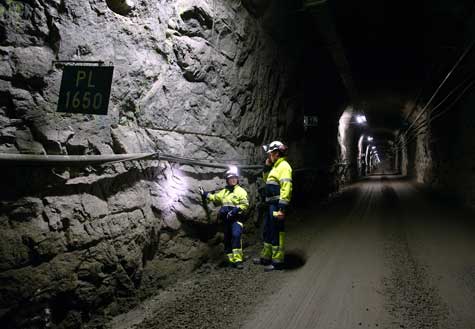 A scene from Into Eternity, a documentary that looks at Finland’s plans to store the country’s nuclear waste for 100,000 years. Yep … 100,000. Photo: PosivaThis piece was written by Lewis Beale.
A scene from Into Eternity, a documentary that looks at Finland’s plans to store the country’s nuclear waste for 100,000 years. Yep … 100,000. Photo: PosivaThis piece was written by Lewis Beale.
The first documentary that Netflix might slot into their science fiction category, director Michael Madsen’s Into Eternity, is an eerily fascinating look at the planet’s most unique construction project.
Known as Onkalo — “hiding place” in Finnish — this massive work in the north of Finland, which began construction in the last century and won’t be completed until the next one, is a series of concrete-reinforced underground tunnels meant to store the country’s nuclear waste. And it’s designed to last until the waste is harmless — a full 100,000 years.
Say it again — 100,000 years. The figure is mind-boggling, and that’s one of the points the film — currently playing in New York and soon to be released around the country — sets out to make. How do you plan something that’s supposed to last that long? How do you build it? And when it’s finished, should you warn future generations what lies 500 feet under the Finnish forest or hope that the project will be forgotten and no one will unintentionally stumble upon it?
Onkalo is, in fact, the first project of its kind, so the engineers and scientists interviewed in the film are definitely pioneers of a sort. “Everyone is waiting to see if Finland can pull this off,” said Madsen (not to be confused with the Reservoir Dogs star) during a phone interview. “No one knows the right way to do this, and no one knows if it will work. That means even the nuclear safety authorities don’t know what the standards are.”
Fact is, something needs to be done with the estimated 250,000 tons of nuclear waste worldwide. Right now, interim storage is available above ground in steel containers submerged in water, but no one seems to know how long this solution will be viable. And as one of the film’s talking heads puts it, “The world above ground is unstable.”
Which is why the Finns decided to build Onkalo in solid bedrock that’s been around for about 1 billion years and is not susceptible to earthquakes. Construction, which began in 2003, will eventually consist of 2.5 miles of tunnels organized in what is described as a “Russian doll” configuration — if the barrier to one tunnel fails, the barrier to another can mitigate any possible consequences. And once construction is finished sometime in the 22nd century, a concrete seal will be cast at the tunnel mouth, and shut for all eternity. Then the land above it will be backfilled and eventually returned to its natural state.
All well and good. The plan seems, on its surface, well thought out. But beyond construction discussions, Into Eternity gets into some seriously futuristic issues. For one thing, Madsen films a lot of the tunnel footage in loving tracking shots, including some scenes of construction equipment set to the strains of Jean Sibelius’ “Valse Triste.” It’s like watching a real-life version of that scene in 2001: A Space Odyssey, where shots of a spinning space station are set to Strauss’ “Blue Danube” waltz:
But it is Madsen’s questions about future generations, and what they should be told about the project, that really set the film spinning off into the province of writers like William Gibson and Joe Haldeman. Most of the scientists don’t seem worried about human intrusion and even question if future generations will understand the purpose of Onkalo or even have advanced enough technology to penetrate it. Who knows, after all, if 100,000 years into the future, humankind will have regressed technologically or left the planet for a new home in the stars?
Which is why some experts believe the project should be left untended and forgotten, or, as one scientist puts it, “to remember forever to forget.” But others think the site should be marked with warnings, although when they start thinking about exactly how to communicate with future generations, you can almost see the brains of these intellects start to sizzle with frustration. What kind of spoken language will Future Human be using? Will pictograms do the trick? And if so, who knows if today’s universal symbol for nuclear danger will have any meaning thousands of years into the future?
It all comes under what one commentator labels “decisions under uncertainty” — what you know you don’t know, and what you don’t know you don’t know.
“I think what is most significant about the project is that these experts, the people building it, are more inclined to talk about the technical aspects rather than the actual problem, which is the time span and should we warn the future or not,” said Madsen. “It is possible to understand the argument that it should be forgotten, which the Finnish engineers tend to advocate. But how do you create forgetting? And if you go for that one, you have to be overly confident in what you’re building — ‘We’re giving a 100,000-year warranty on this building’ — and that is hubris.”
Hubris? Or faith in the future? Into Eternity tends to leave the answer up to the viewer, but as far as Madsen is concerned, the answer to those questions is self-evident.
“We have to watch the future,” he said. “To assume it is foolproof — that’s nonsense.”
This article was syndicated with permission from Miller-McCune, an online and print magazine that focuses on practical options for solving serious problems, particularly if the options are backed by quality research and evidence.



